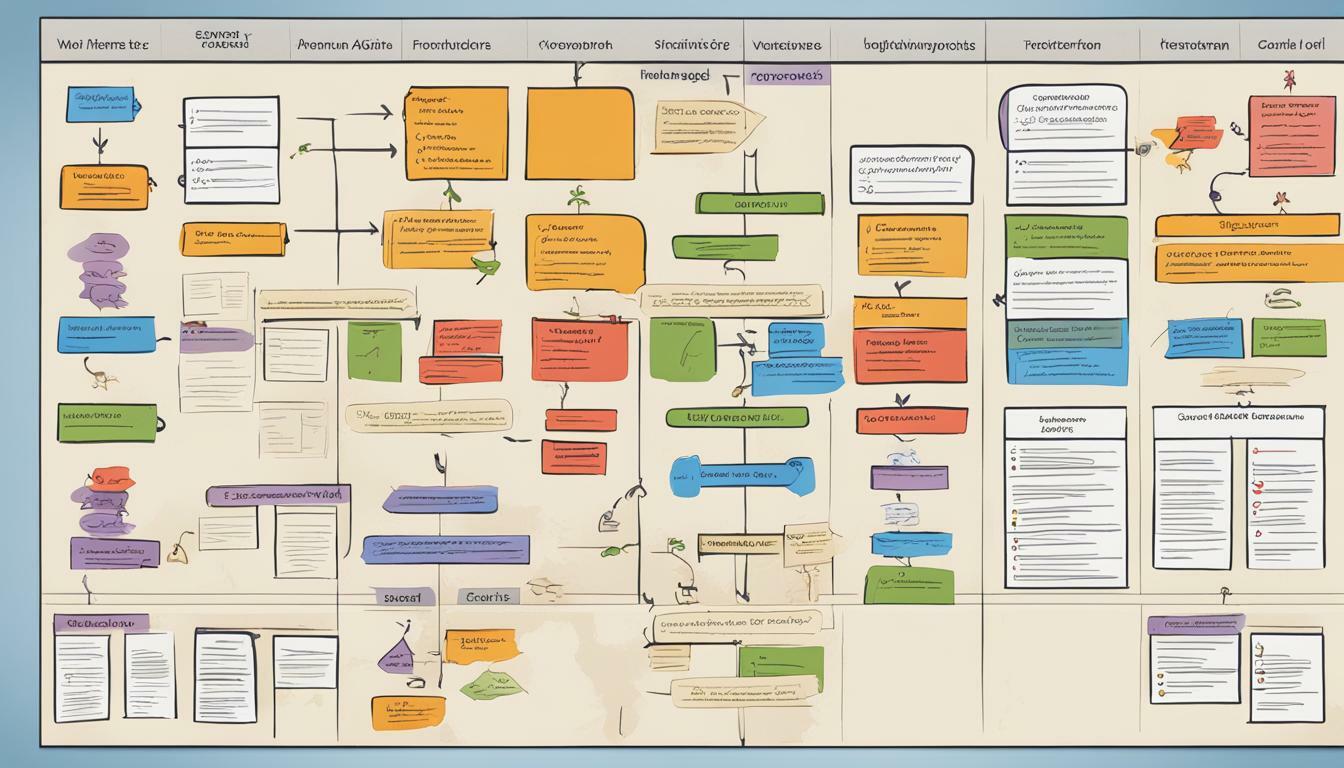
Agile methodologies have become increasingly popular in recent years, as more teams seek to optimize their productivity and results. However, with so many different agile frameworks to choose from, it can be challenging to know which one is right for your team. In this article, we’ll explore the debate between Scrum and Kanban, two of the most well-known agile frameworks, and provide insights to help you make an informed decision.
Key Takeaways:
- Choosing the right agile framework is crucial for optimizing productivity and results.
- Scrum and Kanban are two popular agile frameworks that offer different approaches to team management and project management.
- Consider factors such as team size, project complexity, flexibility, and adaptability when deciding between Scrum and Kanban.
Understanding Agile Methodologies
Agile methodologies have revolutionized the way teams manage and execute projects. They are designed to enhance collaboration, flexibility, and innovation, providing a framework for quick and responsive delivery. Two of the most popular agile frameworks are Scrum and Kanban.
The Scrum framework is a time-boxed, iterative approach that emphasizes teamwork, transparency, and continuous improvement. It consists of three roles, including the Product Owner, Scrum Master, and Development Team, and four ceremonies, including Sprint Planning, Daily Scrum, Sprint Review, and Sprint Retrospective. The Scrum framework is best suited for complex projects that require a high level of collaboration and a clear focus on delivering value to the customer.
The Kanban framework is a visual system that emphasizes flow, efficiency, and optimization. It uses a Kanban board to visualize workflows and manage work in progress, with an emphasis on minimizing bottlenecks and reducing cycle time. The roles in Kanban are less defined, and there are no formal ceremonies. The Kanban framework is best suited for projects with a high degree of variability and unpredictability, where flexibility and adaptability are critical.
Agile methodologies are not only about frameworks but also about team management. They promote a culture of collaboration, trust, and responsibility, with a focus on delivering value to the customer. Agile project management involves breaking down complex tasks into smaller, manageable units, using feedback loops to refine and improve performance, and embracing change as a source of innovation and improvement.
Exploring the Scrum Framework
The Scrum methodology is an agile framework that promotes iterative and incremental development to deliver high-value products in a timely and efficient manner. It emphasizes collaboration, flexibility, and continuous improvement, creating a shared understanding of the project goals and progress within the team.
Scrum is based on three key roles: the Product Owner, the Scrum Master, and the Development Team. The Product Owner is responsible for defining and prioritizing the project requirements, ensuring that the team is working on the most valuable items first. The Scrum Master serves as a coach and facilitator for the team, removing any obstacles that may impede their progress and ensuring that they adhere to the Scrum principles and practices. The Development Team is a self-organizing and cross-functional group of individuals that are accountable for delivering a potentially shippable product increment at the end of each sprint, typically lasting 1-4 weeks.
The Scrum framework consists of a set of ceremonies, including Sprint Planning, Daily Stand-up Meetings, Sprint Review, and Sprint Retrospective. Sprint Planning is a collaborative meeting where the team defines the sprint goal, selects the items from the product backlog that they will work on, and creates a sprint backlog. Daily Stand-up Meetings are short and focused meetings held each day to review progress, identify any impediments, and plan for the next 24 hours. Sprint Review is a demo meeting held at the end of each sprint to showcase the work completed and get feedback from stakeholders. Sprint Retrospective is a team reflection meeting held after each sprint, where they discuss what went well, what could be improved, and define action items for the next sprint.
When comparing Scrum to Kanban, Scrum is often perceived as a more structured and prescriptive framework, providing clear guidelines and expectations for the team. It gives more emphasis to time-boxed sprints, while Kanban allows for more continuous flow of work. Scrum also provides more defined roles and ceremonies, while Kanban allows for more flexibility in terms of team organization and process management.
Unveiling the Kanban Framework
The Kanban methodology is a popular agile framework that emphasizes continuous delivery and workflow management. Unlike Scrum, which is based on timeboxed sprints, Kanban is a more flexible approach that focuses on limiting work-in-progress, optimizing flow, and continuous improvement.
The core principles of Kanban revolve around visualizing workflows, limiting work-in-progress, managing flow, making policies explicit, implementing feedback loops, and improving collaboratively and evolve experimentally. These principles help teams to identify bottlenecks, eliminate waste, and deliver value faster and more reliably.
| Kanban Framework | Scrum Framework |
|---|---|
| Based on continuous flow | Based on timeboxed sprints |
| Focuses on workflow optimization | Focuses on sprint planning and execution |
| Allows for flexibility and adapting to change | Requires adherence to predefined roles, ceremonies, and artifacts |
Compared to Scrum, Kanban offers greater flexibility, adaptability, and visibility, making it a particularly good fit for teams that deal with changing priorities, frequent interruptions, and varying demand. However, it may not be as suitable for complex projects that require more structure and planning.
Using Kanban requires a visual board system that shows the work items, their progress, and any blockers or impediments. This can be a physical board with sticky notes or an online tool that facilitates collaboration and real-time updates. Team members collaborate to move items across the board, allowing for a continuous flow of work.
Overall, the Kanban framework is a powerful tool for improving workflow management and delivering value faster. While it may not be the best fit for every team and project, it offers unique advantages and potential benefits when used correctly.
Factors to Consider when Choosing an Agile Framework
Choosing between Scrum and Kanban can be challenging, as both methodologies offer distinct advantages and disadvantages depending on the team’s specific needs. To help make an informed decision, here are some factors to consider when comparing Scrum vs. Kanban:
- Team size: Scrum works well for larger teams, whereas Kanban is more suitable for smaller teams.
- Project complexity: Scrum is recommended for complex projects with many uncertainties, while Kanban is best for projects with straightforward workflows and predictable tasks.
- Flexibility: Scrum provides greater flexibility for adapting to changes in the project scope and requirements, whereas Kanban offers more flexibility in terms of continuous delivery and improvement.
- Adaptability: Scrum requires adherence to a fixed set of roles, ceremonies, and guidelines, while Kanban is more adaptable and allows for more customization and experimentation.
Ultimately, the choice between Scrum and Kanban depends on the specific needs and preferences of the team, as well as the nature of the project at hand. By carefully evaluating these factors and conducting a Scrum vs. Kanban comparison, teams can make an informed decision and select the appropriate agile framework for their unique situation.
Best Practices for Implementing Scrum
The Scrum framework is a popular Agile methodology used by teams to manage projects effectively. To implement Scrum successfully, it is important to follow best practices that ensure optimal productivity and results. Here are some key tips:
- Plan Sprints Effectively: Sprints are the heart of the Scrum framework. To plan sprints effectively, make sure to prioritize the backlog, estimate the effort involved, and assign tasks to team members based on their skills and availability. This ensures that everyone knows what to do and that there are no roadblocks in the sprint.
- Hold Daily Stand-up Meetings: Daily stand-up meetings are a crucial element of Scrum. These 15-minute meetings provide a platform for team members to update each other on progress, discuss any blockers, and plan for the day ahead. To make these meetings worthwhile, encourage team members to be concise and focus on what they need.
- Manage the Backlog: The backlog is the list of features or tasks that need to be completed for the project. To manage the backlog effectively, ensure that it is constantly updated, and prioritize items based on their importance. This helps teams to work on the most valuable items first and makes it easier to plan sprints.
- Conduct Sprint Reviews: At the end of a sprint, it is vital to conduct a review to assess what was accomplished and identify areas for improvement. This helps the team to continually adapt and refine their processes, ensuring that they are always working towards the project’s objectives.
By following these best practices, teams can implement Scrum effectively and achieve their project goals efficiently. It enables team members to collaborate, communicate better, and focus on delivering value to the customer.
Best Practices for Implementing Kanban
Implementing the Kanban framework effectively requires a deep understanding of its core principles. Here are some best practices to help you make the most of this agile methodology:
- Visualize workflows: Use a board or a digital tool to visualize your workflow, from start to finish, ensuring you add all tasks to the appropriate columns.
- Set work-in-progress (WIP) limits: Limit the number of tasks a team can work on simultaneously by setting WIP limits for each column. This will help prevent overloading and improve focus.
- Measure cycle time: Track the time it takes to complete a task from start to finish. This will provide insights into your team’s efficiency and help identify potential bottlenecks.
- Continuously improve: Use regular retrospectives to review your progress, identify areas for improvement, and make adjustments to your workflows and processes as necessary.
By following these best practices, your team can optimize their workflow management and achieve better results with the Kanban framework.
Conclusion
Choosing the right agile framework for your team is crucial for achieving optimal productivity and results. While Scrum and Kanban are both popular agile methodologies, they differ in their approach to team management and project management.
When deciding between Scrum and Kanban, it’s important to consider factors such as team size, project complexity, flexibility, and adaptability. Each framework offers its unique benefits and limitations, and the decision ultimately comes down to your team’s specific needs and preferences.
Implementing either Scrum or Kanban requires a certain level of best practices to ensure successful adoption. For Scrum, best practices include sprint planning, daily stand-up meetings, backlog management, and sprint reviews. For Kanban, the best practices include visualizing workflows, setting work-in-progress limits, measuring cycle time, and continuous improvement.
In Conclusion
At the end of the day, Scrum and Kanban are both great agile frameworks. While they differ in their approach, both methodologies aim to provide teams with a flexible and effective way to manage projects. By carefully considering your project goals and team dynamics, you can choose the right agile framework that will work best for your organization’s needs. Keep in mind that implementing best practices for either Scrum or Kanban can help you achieve optimal results.
FAQ
Q: What is the difference between Scrum and Kanban?
A: Scrum and Kanban are both agile frameworks, but they have different approaches. Scrum is more structured and focuses on iterations called sprints, while Kanban is more flexible and visualizes workflow through a board system.
Q: Which agile framework is best for my team?
A: The best framework depends on various factors, such as team size, project complexity, and desired level of flexibility. Scrum works well for teams that prefer structure and predefined iterations, while Kanban is suitable for teams that value flexibility and continuous workflow.
Q: How do I implement Scrum effectively?
A: To implement Scrum effectively, it is essential to have proper sprint planning, daily stand-up meetings, backlog management, and sprint reviews. These practices help ensure effective communication, collaboration, and progress tracking within the team.
Q: What are the key principles of Kanban?
A: The key principles of Kanban include visualizing workflows, setting work-in-progress limits, measuring cycle time, and continuously improving the process. These principles help teams manage their work efficiently and identify areas for improvement.
Q: Can Scrum and Kanban be combined?
A: Yes, Scrum and Kanban can be combined to create a hybrid framework called Scrumban. This allows teams to benefit from the structured approach of Scrum while also incorporating the flexibility and visualization aspects of Kanban.
Q: How do I decide between Scrum and Kanban?
A: When deciding between Scrum and Kanban, consider factors such as team size, project complexity, and desired level of flexibility. Evaluate which framework aligns better with your team’s needs and goals to make an informed decision.
Q: What are the advantages of using Scrum?
A: Some advantages of using Scrum include increased transparency, improved collaboration, predictable delivery, and the ability to adapt to changing requirements. Scrum provides a structured framework for teams to effectively manage their projects.
Q: What are the benefits of using Kanban?
A: Kanban offers benefits such as visualizing workflow, limiting work in progress to improve focus, identifying bottlenecks, and promoting continuous improvement. It provides teams with a flexible framework for managing their work efficiently and continuously optimizing their processes.








